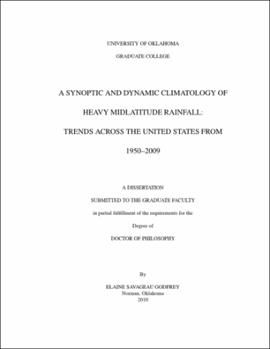| dc.contributor.advisor | Crawford, Kenneth||Richman, Michael | |
| dc.creator | Godfrey, Elaine Savageau | |
| dc.date.accessioned | 2019-04-27T21:38:50Z | |
| dc.date.available | 2019-04-27T21:38:50Z | |
| dc.date.issued | 2010 | |
| dc.identifier | 9947884502042 | |
| dc.identifier.uri | https://hdl.handle.net/11244/319259 | |
| dc.description.abstract | The increasing regularity and intensity of heavy precipitation events across the United States during the latter part of the 20th century is widely recognized. Many climate models predict continued growth in the proportion of precipitation from extreme rainfall events concurrent with the projected increase in average global temperatures. | |
| dc.description.abstract | To evaluate heavy precipitation events on a regional scale, the principal component analysis (PCA) technique is applied using the expanded version of the evenly-distributed Richman-Lamb precipitation dataset. The PCA technique identifies climatologically similar regions with respect to rainfall in the United States east of the Rocky Mountains over a 52-year period. Results revealed 13 regions of coherent precipitation patterns across the eastern two-thirds of the Continental U.S. | |
| dc.description.abstract | A subset of observations from the Global Historical Climatology Network-Daily dataset | |
| dc.description.abstract | for the same domain was used to identify heavy and significant rainfall events between | |
| dc.description.abstract | 1950-2009. The heavy event definition is based on the 90th or higher percentile of total | |
| dc.description.abstract | precipitation events with at least 1 inch (25 mm) of rainfall. Similarly, significant events | |
| dc.description.abstract | were the top twenty unique heavy events in each region. Furthermore, when the heavy and significant events were stratified by decade, region, and/or season, meaningful spatial and temporal trends were revealed. | |
| dc.description.abstract | The NCEP-NCAR 40-Year Reanalysis data were used to create composite synoptic | |
| dc.description.abstract | maps from the significant events in each region. A region-by-region analysis revealed | |
| dc.description.abstract | strong similarities but unique differences in the synoptic-scale environment associated | |
| dc.description.abstract | with non-tropical significant events across different regions. A national composite of nontropical events from inland regions enabled the identification of common patterns in the synoptic environments associated with significant events. A comparison of national composites from the first half and second half of the study period enabled the assessment of potential temporal trends in the synoptic-scale environment. Of all variables, precipitable water had a noticeable increase in the post-1980 significant events over those prior to 1980. | |
| dc.description.abstract | The final work on this research focused on the dynamical forcings (as calculated using terms in the Q-G Omega equation) and assessed possible temporal trends that occurred in the troposphere during the course of the significant precipitation events. This study discovered that, during episodes of significant rainfall, vorticity advection plays little role in initiating or modulating the rainfall event. Instead, thickness advection is by far the most dominant synoptic-scale forcing mechanism to initiate an outbreak of heavy to significant rainfall. | |
| dc.format.extent | 189 pages | |
| dc.format.medium | application.pdf | |
| dc.language | en_US | |
| dc.relation.requires | Adobe Acrobat Reader | |
| dc.subject | Precipitation (Meteorology)--United States | |
| dc.subject | Climatology | |
| dc.subject | Principal components analysis | |
| dc.title | A Synoptic and Dynamic Climatology of Heavy Midlatitude Rainfall: Trends Across the United States from 1950-2009 | |
| dc.type | text | |
| dc.type | document | |
| dc.thesis.degree | Ph.D. | |
| ou.group | College of Atmospheric & Geographic Sciences::School of Meteorology | |
